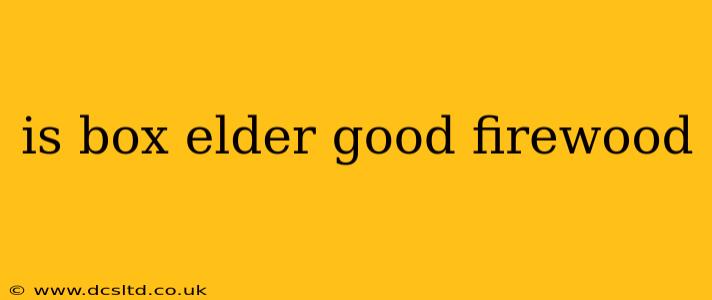Is Box Elder Good Firewood? A Comprehensive Guide
Box elder, often confused with maple due to its similar appearance, is a tree that sparks debate among firewood enthusiasts. Is it good firewood? The answer, like many things in life, is nuanced. While not the best firewood, it certainly has its place and can be a useful addition to your woodpile under the right circumstances. This guide will delve into the pros and cons of using box elder as firewood, addressing common questions and concerns.
What are the characteristics of box elder wood?
Box elder wood is relatively soft and light compared to hardwoods like oak or hickory. This makes it easier to split, particularly for those with less experience or physical strength. However, this softness also translates to a lower density, meaning it burns quicker and produces less heat overall than denser hardwoods. Its low density also contributes to a lower BTU output, meaning you'll need to burn more to achieve the same level of warmth.
How does box elder burn?
Box elder burns quickly and with a relatively bright, hot flame initially. However, it doesn't have the long, slow burn of denser hardwoods. This means you'll need to add more wood more frequently to maintain a consistent fire. It also tends to produce more sparks and embers than some other hardwoods, so careful attention is required.
What are the pros of using box elder as firewood?
- Easy to Split: Its softness makes it easy to split, even with less powerful tools. This is a significant advantage for those new to splitting wood or those with physical limitations.
- Burns Brightly: While the burn time is shorter, the flame is bright and produces good heat initially, making it ideal for quick fire-starting.
- Readily Available: Depending on your location, box elder may be a readily available option, potentially reducing transportation costs and effort.
- Good for kindling: The ease of splitting and quick burning nature makes box elder excellent kindling to start larger fires.
What are the cons of using box elder as firewood?
- Low BTU Output: Box elder produces less heat per unit of volume than denser hardwoods, meaning you'll need to burn more to achieve the same warmth.
- Short Burn Time: Its soft nature leads to a relatively short burn time compared to hardwoods.
- Produces More Ash: Due to its softer nature, box elder can produce more ash than denser hardwoods, requiring more frequent cleaning of your fireplace or wood stove.
- Can Be Messy: The propensity for sparks and embers necessitates more careful monitoring of the fire.
Is box elder better than other softwoods?
While box elder is considered a softwood in terms of its burning characteristics, it's generally considered superior to most true softwoods like pine or fir. Softwoods tend to burn even faster, create more creosote buildup in chimneys, and produce less heat. Box elder offers a middle ground, making it a reasonable choice if other hardwoods aren't readily available.
Is box elder good for smoking meat?
Box elder is not generally recommended for smoking meat. Its flavor profile is often considered unpleasant and can impart an undesirable taste to your food. Stick to established smoking woods like hickory, mesquite, or applewood for better results.
What is the best way to season box elder firewood?
Seasoning box elder is crucial to improving its burning quality. Proper seasoning (allowing the wood to dry for at least 6-12 months before burning) reduces moisture content, leading to a cleaner burn and less smoke. Stack the wood in a well-ventilated area, allowing for airflow around the pieces.
In conclusion, box elder isn't the ideal firewood, but it's a serviceable option, especially for those who prioritize ease of splitting and quick fire-starting. Its lower BTU output and shorter burn time should be considered, and using it as a supplement to denser hardwoods is often the most practical approach. Understanding its characteristics will allow you to use it effectively and appreciate its place within a diverse woodpile.
